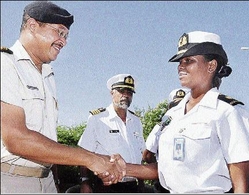Ship ahoy! - Antoinette Blake pursues a maritime career
Published: Wednesday | December 2, 2009

Antoinette Blake receiving first-year awards at the Maritime Institute of Jamaica. - Contributed
Nineteen-year-old Antoinette Blake, who has just completed the first phase of her seafaring training at the Caribbean Maritime institute (CMI) in Kingston, left the island via ship in September with the Belgian line EXMAR to begin the next leg of the process which will transform her into a fully fledged maritime officer, specialising in navigation.
Fritz Pinnock, head of the CMI states that Blake and three other top cadets on board the vessel are doing well.
"They spent some time in the Middle East and had the experience of passing through Somalia. They are on their way to Norway, and will move on to Canada and Australia afterwards.
"Antoinette is doing well and the company is proud of her as the first female cadet on board their state-of-the-art, highly-specialised gas tanker ship."
Expecting to be immediately employed
While Blake's second year will be spent at sea, her third and final year will be completed back home at the Maritime Institute in Jamaica. Upon graduation, she is expecting to be immediately employed.
Currently, there is a shortage of some 80,000 workers internationally in the maritime industry, and as fast as workers are trained by the CMI they are employed, Fritz Pinnock, executive director of the institute asserts.
But, more than the high demand was Blake's superlative performance during her first year at the Maritime Institute. She placed as the top student of 52 students in her class at the end of first year in June 2009. Among the students were 11 females and 41 males.
At the CMI, students can enrol in either land-based or seafaring programmes. The two land-based courses are the Associate of Applied Science Degree in Industrial Systems, Operations and Maintenance and the Diploma in International Shipping and Logistics. The two seafaring programmes are the Officer in Charge of Engineering Watch and Officer in Charge of Navigational Watch.
To qualify for the first phase of the seafaring programmes, prospective students must also be medically fit, have a clean police record, and must also successfully complete an interview with the CMI admissions committee.
With no history of military service in her family, Blake nevertheless, had always been intrigued by such careers and says she selected the CMI over medicine or aeronautical engineering - fields which also held her interest.
The graduate of Bishop Gibson high school was a cadet at school and says she has had no problem with the high levels of discipline required at the CMI.
Aspiration
"I want to be the first female ship captain," she states.
In her first year at the Institute, academics was what was taught between September 2008 and June 2009. Core subjects included mathematics, physical sciences, Spanish, communication skills and information technology.
Professional courses included coastal navigation, use of signals, maritime legislation, celestial navigation, electronic navigation, ship construction, seamanship, cargo handling and sewage, watch keeping and, collision regulation.
"I am mathematics-oriented so the subjects were okay," Blake said.
But, added to this was cadet training which was quite strict. For one and a half hours after classes every day, students would do navy drills. The cadet system awarded points with, 30 per cent overall going to final grades. The remainder of final grades came from tests. For Blake the results were excellent.
Now that she is at sea, she will be experiencing navigation training during six months of hands-on contact.
After the end of the seafaring phase, she will return to the Maritime Institute to attend classes again and complete external examinations at the Maritime Authority. If successful, she will be fully licensed.
avia.collinder@gleanerjm.com







